italian

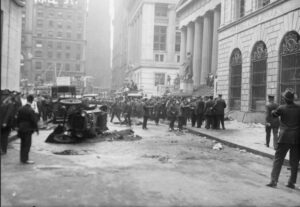 Acts of terrorism somehow seem to be a normal possibility in the times we live in, but are they just a phenomenon that exists in our current era? Not really. While they may have been to a lesser degree, these kinds of things have been around fora long time. On September 16, 1920, during a busy day on Wall Street, New York was hit by an unforeseen event. Bankers and stockbrokers were bustling around with an average day in the financial world. Then, as the church bells struck 12 noon, 100 pounds of dynamite detonated in front of the Assay Office.
Acts of terrorism somehow seem to be a normal possibility in the times we live in, but are they just a phenomenon that exists in our current era? Not really. While they may have been to a lesser degree, these kinds of things have been around fora long time. On September 16, 1920, during a busy day on Wall Street, New York was hit by an unforeseen event. Bankers and stockbrokers were bustling around with an average day in the financial world. Then, as the church bells struck 12 noon, 100 pounds of dynamite detonated in front of the Assay Office.
Concealed in a horse-drawn wagon that had been parked for some time in front of the Assay Office, the bomb suddenly exploded. An employee of J.P. Morgan, Andrew Dunn said, “That was the loudest noise I ever heard in my life. It was enough to knock you out by itself.” The normally businesslike street was instantly transformed into what looked more like a battlefield than a financial district. There was debris, blood, and charred bodies everywhere. Thirty men and women lost their lives instantly. Eight more would die of their injuries later on. Hundreds of people were injured with many of them getting serious burns.
At the site of the 1920 Wall Street bombing, pock marks from the bomb are still visible to this day. Apparently, there was some warning of the impending attack, because a day after the attack, postal workers uncovered flyers that have been dropped into the mailboxes in Wall Street. The flyers read, “Remember, we will not tolerate any longer. Free the political prisoners, or it will be sure death for all of you.” It was signed the American Anarchist Fighters. Authorities immediately suspected the Galleanists, a gang of anti-government Italian anarchists led by Luigi Galleani, but unfortunately, they could not uncover any evidence to charge them with the crime. While the FBI had numerous leads, they couldn’t come close to any significant evidence. The investigation went on for years and was finally delegated a cold cast with the last known investigation taking 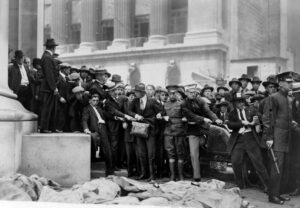
 place in 1944. Finally, the FBI concluded that the explosion was most likely caused by “Italian anarchists or Italian terrorists.” Nevertheless, they could not prove anything, and no one was ever charged with the crime. Mario Buda, a Galleanist, was considered as a likely suspect, but with no proof, he was never charged. No one has ever claimed responsibility for the attack even after 102 years.
place in 1944. Finally, the FBI concluded that the explosion was most likely caused by “Italian anarchists or Italian terrorists.” Nevertheless, they could not prove anything, and no one was ever charged with the crime. Mario Buda, a Galleanist, was considered as a likely suspect, but with no proof, he was never charged. No one has ever claimed responsibility for the attack even after 102 years.
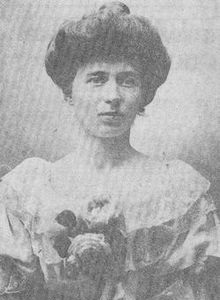 Recently I read a novel that was based on a true story, called “The Alice Network,” by Kate Quinn. Knowing the book was a novel, I assumed that it was entirely fictional, but then I began to wonder, so I researched “The Alice Network” for myself. I found that “The Alice Network” was a very much true story, even if some of the characters in the story were fictional. The head of the Alice Network, Louise Marie Jeanne Henriette de Bettignies, was very much a real person.
Recently I read a novel that was based on a true story, called “The Alice Network,” by Kate Quinn. Knowing the book was a novel, I assumed that it was entirely fictional, but then I began to wonder, so I researched “The Alice Network” for myself. I found that “The Alice Network” was a very much true story, even if some of the characters in the story were fictional. The head of the Alice Network, Louise Marie Jeanne Henriette de Bettignies, was very much a real person.
Louise Marie Jeanne Henriette de Bettignies was born on July 15, 1880 to Henri de Bettignies and Julienne Mabille de Poncheville. She was fluent in French and English, with a good mastery in German and Italian. It made her a perfect candidate for the spy network. Louise became a French secret agent who spied on the Germans for the British during World War I using the pseudonym of Alice Dubois, hence “The Alice Network.” She had under her direction, a number of men and women who mainly worked in the area of Lille, in German occupied France. Her people listened inconspicuously to the talk of the German soldiers when they were not aware, and therefore, not careful to guard their tongues. The gleaned intel was then passed to couriers, of which Louise was one, to be transported by car, train, or on foot to the military leaders they worked for. It was a dangerous occupation, but the spies in the network wanted to serve in the war effort, and this was their chance.
Spies in “The Alice Network” and other such networks, went to work in jobs that were basically normal everyday jobs. They became waitresses, singers, shop workers, all in areas frequented by the enemy. They swallowed their disgust, in order to become almost invisible to the Germans. They never told anyone that they spoke German, because the Germans felt comfortable talking in front of these people who, they thought, couldn’t understand a word they said. It gave the spy networks just the edge they needed. Some spies, like Louise, spent time in makeshift hospitals writing letters in German dictated by dying Germans to their families. Dying men aren’t always careful with the information they give. A wealth of information was passed from these networks to the intelligence officers, and it often proved to be invaluable.
Louise lived with her sister, Germaine at 166 rue d’Isly. From October 4 to 13, 1914, by turning the only cannon that the Lille troops had, the defenders succeeded in deceiving the enemy and holding them for several days under an intense battle that destroyed more than 2,200 buildings and houses, particularly in the area of the station. Louise de Bettignies, aged 28, making full use of the four languages she spoke, including German and English. Through the ruins of Lille, she ensured the supply of ammunition and food to the soldiers who were still firing on the attackers. Then, since she had been a citizen of Lille since 1903, Louise made the decision in October 1914, to engage in resistance and espionage. Due in part to her ability to speak French, English, German, and Italian, she ran a vast intelligence network from her home in the North of France on behalf of the British army and the MI6 intelligence service under the pseudonym Alice Dubois. This network provided important information to the British through occupied Belgium and the Netherlands. The network is estimated to have saved the lives of more than a thousand British soldiers during the 9 months of full operation from January to September 1915.
“The Alice Network” of a hundred people, mostly in forty kilometers of the front to the west and east of Lille, was so effective that she was nicknamed by her English superiors “the queen of spies.” She smuggled men to England, provided valuable information to the Intelligence Service, and prepared for her superiors in London a grid map of the region around Lille. When the German army installed a new battery of artillery, even camouflaged, this position was bombed by the Royal Flying Corps within eight days. Another opportunity allowed her to report the date and time of passage of the imperial train carrying the Kaiser on a secret visit to the front at Lille. During the approach to Lille, two British aircraft bombed the train and emerged, but missed their target. The German command did not understand the unique situation of these forty kilometers of “cursed” front (held by the British) out of nearly seven hundred miles of front. One of her last messages announced the preparation of a massive German attack on Verdun in early 1916. The information was relayed to the French commander who refused to believe it. Incredible!!! After all her success, this worthless French commander refused to believe her. Idiot!!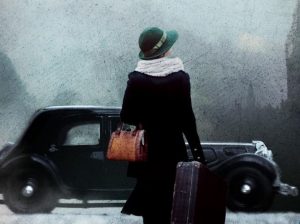
Louise was arrested by the Germans on October 20, 1915 near Tournai. On March 16, 1916, in Brussels, she was sentenced to forced labor for life. After being held for three years, she died on September 27, 1918 as a result of pleural abscesses poorly operated upon at Saint Mary’s Hospital in Cologne. Her body was repatriated on February 21, 1920. On March 16, 1920 a funeral was held in Lille in which she was posthumously awarded the Cross of the Legion of Honor, the Croix de guerre 1914-1918 with palm, and the British Military Medal, and she was made an Officer of the Order of the British Empire. Her body is buried in the cemetery of Saint-Amand-les-Eaux.
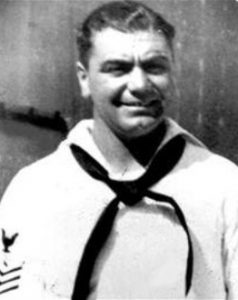 When we think of movie stars, we seldom think of them as soldiers, even if they have played a soldier on television or the movies. Nevertheless, many have served. One of my favorite shows as a kid was McHale’s Navy. McHale was played by Ernest Borgnine, who was born Ermes Effron Borgnino on January 24, 1917, in Hamden, Connecticut. Borgnine was the son of Italian immigrants. His mother, Anna (née Boselli; 1894–c. 1949), was from Carpi, near Modena. His father Camillo Borgnino (1891–1975) was a native of Ottiglio near Alessandria.
When we think of movie stars, we seldom think of them as soldiers, even if they have played a soldier on television or the movies. Nevertheless, many have served. One of my favorite shows as a kid was McHale’s Navy. McHale was played by Ernest Borgnine, who was born Ermes Effron Borgnino on January 24, 1917, in Hamden, Connecticut. Borgnine was the son of Italian immigrants. His mother, Anna (née Boselli; 1894–c. 1949), was from Carpi, near Modena. His father Camillo Borgnino (1891–1975) was a native of Ottiglio near Alessandria.
Borgnine had a normal childhood, and after high school, he enlisted in the United States Navy in October 1935. He served aboard the destroyer/minesweeper USS Lamberton and was honorably discharged from the Navy in October 1941. Then, the 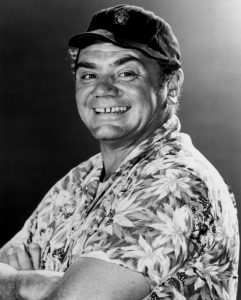 attack on Pearl Harbor on December 7, 1942, changed many things. In January 1942, Borgnine re-enlisted in the Navy. During World War II, he patrolled the Atlantic Coast on an antisubmarine warfare ship, the USS Sylph. In September 1945, he was honorably discharged from the Navy. With the two stints, Borgnine served a total of almost ten years in the Navy and obtained the grade of gunner’s mate 1st class. His military awards include the Navy Good Conduct Medal, American Defense Service Medal with Fleet Clasp, American Campaign Medal with ?3?16″ bronze star, and the World War II Victory Medal. Who knew?
attack on Pearl Harbor on December 7, 1942, changed many things. In January 1942, Borgnine re-enlisted in the Navy. During World War II, he patrolled the Atlantic Coast on an antisubmarine warfare ship, the USS Sylph. In September 1945, he was honorably discharged from the Navy. With the two stints, Borgnine served a total of almost ten years in the Navy and obtained the grade of gunner’s mate 1st class. His military awards include the Navy Good Conduct Medal, American Defense Service Medal with Fleet Clasp, American Campaign Medal with ?3?16″ bronze star, and the World War II Victory Medal. Who knew?
 To me, it seems like all this also prepared him for his most famous television show. As a veteran sailor, he knew how things were run on a ship. Of course, how much of his knowledge could be used on the show depends on the directors. If they had any good sense, they would have used his knowledge, and made the show more realistic. Still, as a kid, I doubt if I would know if it was realistic or not, and after all these years, I can’t say I would recall any of the details. Nor would I know if they were realistic or not. Nevertheless, I always liked the show, and I really liked Ernest Borgnine. I just never knew that he had been a sailor during World War II, or that he had played a part in locating and sinking submarines. I also didn’t realize that he enlisted not once, but twice, or that he served a total of ten years. Years later, on July 8, 2012, after many years as a successful actor, Ernest Borgnine died of kidney failure on July 8, 2012 at Cedars-Sinai Medical Center in Los Angeles, California. He was 95 years old.
To me, it seems like all this also prepared him for his most famous television show. As a veteran sailor, he knew how things were run on a ship. Of course, how much of his knowledge could be used on the show depends on the directors. If they had any good sense, they would have used his knowledge, and made the show more realistic. Still, as a kid, I doubt if I would know if it was realistic or not, and after all these years, I can’t say I would recall any of the details. Nor would I know if they were realistic or not. Nevertheless, I always liked the show, and I really liked Ernest Borgnine. I just never knew that he had been a sailor during World War II, or that he had played a part in locating and sinking submarines. I also didn’t realize that he enlisted not once, but twice, or that he served a total of ten years. Years later, on July 8, 2012, after many years as a successful actor, Ernest Borgnine died of kidney failure on July 8, 2012 at Cedars-Sinai Medical Center in Los Angeles, California. He was 95 years old.

